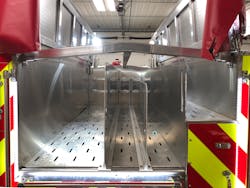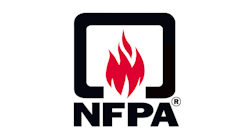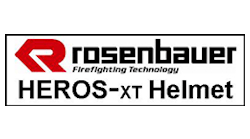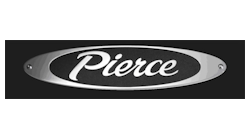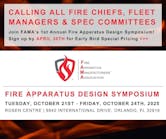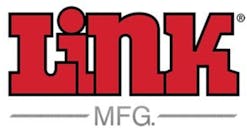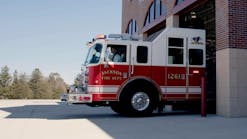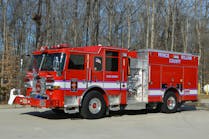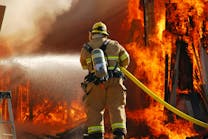Apparatus Hosebed Covers Provide Added Level of Safety
There’s not much sexy about hosebed covers on fire apparatus, but they are required and there are lot of options and some can even enhance apparatus appearance.
Firehouse spoke with a variety of apparatus and hosebed cover manufacturers to learn what’s available and the advantages of each kind.
Options range from webbing and netting to fabric covers or diamond plate metal with power deployment options or roll-up doors, shutter-like covers.
The National Fire Protection Association (NFPA) made hosebed covers mandatory with an interim order in 2003. It was a reaction to some inadvertent and tragic hose lay deployments that caused bodily injury and death as well as property damage.
The NFPA rule, found in the 1901 standard, says: “Any hose storage area shall be equipped with a positive means to prevent unintentional deployment of the hose from the top, side, front and rear of the hose storage area while the apparatus is underway in normal operations.”
Manufacturer's react to standards change
“There have been too many unfortunate incidents,” said Brian Connely, the national sales manager for Spartan Emergency Response. “You don’t want to see someone get hurt.”
Connely said covers for hosebeds, including crosslays and preconnected lines, prevent accidental deployments. They also protect hose from UV rays and the damage sunlight can cause, it keeps the effects of weather at a minimum and they also protect hose from flying embers, an important feature particularly for apparatus working in wildland fires.
At Spartan ER, customers can select everything from simple webbing and hypalon, which is a synthetic rubber material, to hard diamond tread plate as material for hosebed covers.
“The selection should be based on functionality,” Connely said, and that at the minimum, covers should be NFPA compliant “at the very least.”
For the fabric hypalon covers, Spartan ER offers a one-piece unit that rolls over the top of the hoseload and is lifted off when the hose needs to be deployed, Connely said.
Some departments want a hard cover for hosebeds and they spilt them into two or four pieces, depending on size and requirements, and to reduce weight, Connely said.
“They have to have something,” Connely said. “Sometimes, stepping on mesh netting, or fabric covers doesn’t work very well, so a hard cover is a better choice. It all comes down to finances and what you’re looking for. If you’re not looking for something fancy, the fabric and netting is a lower-cost solution.”
A determining factor in cover selection is life of the vehicle, Connely said, noting that fabric covers necessarily don’t last as long as hard covers. Sometimes, departments will come up with their own particular solutions, like one that asked for notches in the hypalon cover to allow for the easy deployment of preconnected hose without the need to remove the whole cover, thus reducing wear and tear.
“It’s all about communications,” Connely said. “If a fire department has an idea for a cover, they need to go back to the manufacturer and talk to them. Sometimes, the manufacturer might be able to say ‘did you consider this’ and a better solution is developed.”
Spartan ER has done everything from the simple hypalon covers with Velcro or snap closures to hard covers with air lifts.
“The idea is to come up with a way to make firefighters’ jobs easier,” he said. “It’s a team effort and we have a wide variety of options.”
Mike Harstad is vice president of sales for Rosenbauer America and fire chief of the Crooks, SD, Fire Department. For him, the decision about hosebed covers is simply a matter of function.
“You should consider how often you are going to be in the hosebed,” Harstad said, noting his department doesn’t pull hose often, so they’ve opted for hard covers which makes hose completely secured. He said departments that pull hose with high frequency are probably better off with a soft cover.
And the cost difference between a hard cover and a soft cover is only about $1,000. “On the grander scheme, what is the significance of $1,000 on a $500,000 apparatus,” he asks.
Another factor to consider is how often firefighters are going to be on top of the apparatus, accessing coffin compartments, or staffing manual deck guns.
“If firefighters have to walk up there, a vinyl cover is probably not your best choice,” Harstad said. “You’re not supposed to be walking on vinyl hose covers.”
Another option is a powered roll shutter, like ones commonly found on apparatus compartments, he said.
“They are very, very nice and they are very, very rigid,” Harstad said, noting that firefighters can walk on shutters. He added that the only complaint is if the hosebed is overpacked, nozzles and hose can get caught and flake off as the shutters are retracted. Also, the shutters are limited in width and length so they’re not a good option with “monster hosebeds,” Harstad said.
Harstad said that in his experience with Rosenbauer, that because NFPA mandates them, at least 85 percent of the apparatus his company builds are equipped with hosebeds. Of those 85 percent, 40 percent have tread plate hard covers while the less expensive vinyl option makes up the majority.
Vinyl covers are very good for most applications and they can be customized with logos and graphics to the customers’ specifications.
“In our business, they’re mostly red or black, but we can do custom colors too,” he said.
Krystle Holmes, marketing manager for Syntex Industries, maker of vinyl hosebed covers, confirms the company can make a cover in any color the customer desires.
“All our covers are custom made to what you want for your truck,” Holmes said, noting that purple is not out of the question.
To preserve the cover and ensure a longer life, Holmes said departments should use vinyl cleaner on the product.
“It also helps keep it soft for a longer life,” she said.
While there are many ways to attach vinyl covers to apparatus, Syntex’s two most popular closures are Velcro sewn on to the cover and attached to the apparatus or a double grommet system with shock cord sewn into the hem.
“We also have other types of attachments to pick from,” she said, referring customers to the company’s website for more information. Other closures include turn buttons, Lift-a-Dot and snaps.
Customers can also select design patterns on the covers, particularly on the backs of the apparatus where the company can affix Chevron stripping, as well as apparatus numbers, department names and other letters using reflective white or silver material.
“We can customize covers to customer requests,” Holmes said.
Shane Krueger, sales and product development manager for Fire & Emergency Products at Marion Body Works, installs a variety of hosebed covers including tread plate with all manners of lifting devices. It also offers roll-top covers that can be walked upon.
“The age-old vinyl is still, by far, one of the most common covers,” Krueger said.
The type of fastener to hold down fabric covers has been a challenge for Marion, however, he said.
“We find ourselves customizing the hold downs to meet the customer’s demands,” Krueger said.
Through experience, Marion has developed a favorite closure that uses an RV-style slide at the front of the body.
“This design deflects the wind and commonly reduces the stress on fasteners, whether it’s Velcro, Lift-a-Dot, turnbuckle or other designs that hold the cover down to the sides and rear of the vehicle,” he said.
John Schultz is the director of pumper and custom chassis products for Pierce Manufacturing. Like Harstad, Schultz said departments should examine the frequency of hose deployment. Schultz has a little different take, however, on which is better for busier departments.
“If they are typically using attack lines from the hosebed, rather than from some other preconnected hose storage areas, like a front bumper or crosslay, chances are they are more frequently up in the hosebed and repacking hose,” Schultz said. “In this scenario, a cover that deploys quickly and gets out of the way, like a hard cover, or retractor cover, may be the right choice for the department.
He added that if departments are not using hose in the bed often, vinyl or net-type cargo covering might provide the best value for the department over the life of the vehicle.
While simple webbing might have an advantage of a low initial cost, it is merely a restraint device and does not offer the hose any protection from elements, like sun, rain and snow, Schultz said, adding that nylon-based straps stretch over time making them less effective as a restraint.
Vinyl covers also have a low initial cost, but are better at protecting hose from the elements than just webbing, Shultz said. Fabric covers also might likely have to be replaced more frequently over the life of the apparatus, he said, also stressing walking on vinyl is not the best practice. He said to traverse the hosebed, it’s best to undo the fasteners and remove the cover to get it out of the way.
Retractor covers, or shutters, are a good alternative, but they have a much higher cost, Schultz said. He said they work much like a roll-up door on a compartment and have a spool at the front of the hosebed upon which the cover will be stored when it’s open, but noting that this feature will reduce the capacity of the bed.
The retractor hosebed cover does have the advantage of not impeding the catwalks on the sides of apparatus, whereas the tread plate covers that open length-wise in the middle of the hosebed, necessarily block access to the catwalks, which means access to the hosebed is limited to just the rear. The retractors have limits on length and width, depending on the weight of the occupants on top of the apparatus.
In addition to retractor shutter covers, there are several types of powered covers, most open front to back, but some open across the apparatus as well, Schultz said. Opening hard-surface covers can be achieved with hydraulic cylinder systems or some type of electric actuators, Schultz said.
“They are designed to assist the operator in opening and closing the cover by making the process easier and more ergonomic,” he said.
The obvious advantage of hard-surface covers is providing the ability to walk on top of the vehicle to access other areas or equipment, he said.
“The downside of these type of covers is the upfront cost,” he said. “And then they do oftentimes impede access into the hosebed from the catwalk side of the vehicle.” Despite the extra cost up front, he said there’s more being placed in service.
“There’s been an increased use in power-actuated covers, from a safety perspective of trying to keep firefighters off the top of the vehicle to access any type of lock or latch that is on a hydraulic cylinder assist type of cover,” he said.
In terms of innovations, Schultz said there will be continued efforts in keeping firefighters off the tops of apparatus, therefore, he sees more improvements on power-actuation devices and lighter weight material that makes it easier to open and close covers.
“Innovations around the ability to improve firefighter safety will continue to provide value to the customers,” Schultz said.
